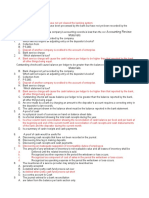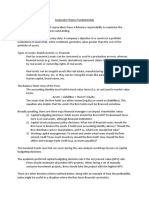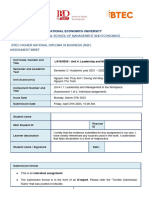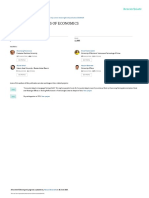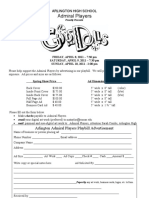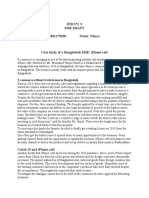McKinsey Explainers
What is leadership?
Leadership is a set of behaviors used to help people align their
collective direction, to execute strategic plans, and to continually
renew an organization.
August 2022
� All leaders, to a certain degree, do the same leaders to focus on the behaviors that are most
thing. Whether you’re talking about an executive, relevant as an organization becomes healthier.
manager, sports coach, or schoolteacher, leadership
is about guiding and impacting outcomes, enabling Senior leaders must develop a broad range of
groups of people to work together to accomplish skills to guide organizations. Ten timeless topics
what they couldn’t do working individually. In are important for leading nearly any organization,
this sense, leadership is something you do, from attracting and retaining talent to making
not something you are. Some people in formal culture a competitive advantage. A 2017 McKinsey
leadership positions are poor leaders, and many book, Leading Organizations: Ten Timeless Truths
people exercising leadership have no formal (Bloomsbury, 2017), goes deep on each aspect.
authority. It is their actions, not their words, that
inspire trust and energy.
How is leadership evolving?
What’s more, leadership is not something In the past, leadership was called “management,”
people are born with—it is a skill you can learn. with an emphasis on providing technical expertise
At the core are mindsets, which are expressed and direction. The context was the traditional
through observable behaviors, which then lead to industrial economy command-and-control
measurable outcomes. Is a leader communicating organization, where leaders focused exclusively
effectively or engaging others by being a good on maximizing value for shareholders. In these
listener? Focusing on behaviors lets us be more organizations, leaders had three roles: planners
objective when assessing leadership effectiveness. (who develop strategy, then translate that strategy
The key to unlocking shifts in behavior is focusing into concrete steps), directors (who assign
on mindsets, becoming more conscious about our responsibilities), or controllers (who ensure people
thoughts and beliefs, and showing up with integrity do what they’ve been assigned and plans are
as our full authentic selves. adhered to).
There are many contexts and ways in which
leadership is exercised. But, according to McKinsey What are the limits of traditional
analysis of academic literature as well as a survey management styles?
of nearly 200,000 people in 81 organizations all
Traditional management was revolutionary in its day
over the world, there are four types of behavior that
and enormously effective in building large-scale
account for 89 percent of leadership effectiveness:
global enterprises that have materially improved
lives over the past 200 years. However, with the
— being supportive
advent of the 21st century, this approach is reaching
its limits.
— operating with a strong results orientation
For one thing, this approach doesn’t guarantee
— seeking different perspectives
happy or loyal managers or workers. Indeed, a large
portion of American workers—56 percent—claim
— solving problems effectively
their boss is mildly or highly toxic, while 75 percent
say dealing with their manager is the most stressful
Effective leaders know that what works in
part of their workday.
one situation will not necessarily work every
time. Leadership strategies must reflect each
For 21st-century organizations operating in today’s
organization’s context and stage of evolution. One
complex business environment, a fundamentally
important lens is organizational health, a holistic
new and more effective approach to leadership is
set of factors that enable organizations to grow and
emerging. Leaders today are beginning to focus
succeed over time. A situational approach enables
on building agile, human-centered, and digitally
enabled organizations able to thrive in today’s
2 What is leadership?
�unprecedented environment and meet the needs learning, and enabling colleagues to build new
of a broader range of stakeholders (customers, mindsets, knowledge, and skills
employees, suppliers, and communities, in addition
to investors). 5. beyond boss to human, showing up as one’s
whole, authentic self
What is the emerging new
approach to leadership? Together, these shifts can help a leader expand
This new approach to leadership is sometimes their repertoire and create a new level of value for
described as “servant leadership.” While there an organization’s stakeholders. The last shift is
has been some criticism of the nomenclature, the the most important, as it is based on developing
idea itself is simple: rather than being a manager a new level of consciousness and awareness of
directing and controlling people, a more effective our inner state. Leaders who look inward and
approach is for leaders to be in service of the take a journey of genuine self-discovery make
people they lead. The focus is on how leaders can profound shifts in themselves and their lives;
make the lives of their team members easier— this means they are better able to benefit their
physically, cognitively, and emotionally. Research organization. That involves developing “profile
suggests this mentality can enhance both team awareness” (a combination of a person’s habits
performance and satisfaction. of thought, emotions, hopes, and behavior in
different circumstances) and “state awareness”
In this new approach, leaders practice empathy, (the recognition of what’s driving a person to take
compassion, vulnerability, gratitude, self- action). Combining individual, inward-looking
awareness, and self-care. They provide appreciation work with outward-facing actions can help create
and support, creating psychological safety so lasting change.
their employees are able to collaborate, innovate,
and raise issues as appropriate. This includes Leaders must learn to make these five shifts at
celebrating achieving the small steps on the way three levels: transforming and evolving personal
to reaching big goals and enhancing people’s well- mindsets and behaviors; transforming teams to
being through better human connections. These work in new ways; and transforming the broader
conditions have been shown to allow for a team’s organization by building new levels of agility,
best performance. human-centeredness, and value creation into the
entire enterprise’s design and culture.
More broadly, developing this new approach to
leadership can be expressed as making five key An example from the COVID-19 era offers a useful
shifts that include, build on, and extend beyond illustration of this new approach to leadership. In
traditional approaches: pursuit of a vaccine breakthrough, at the start of
the pandemic Moderna CEO Stéphane Bancel
1. beyond executive to visionary, shaping a clear increased the frequency of executive meetings
purpose that resonates with and generates from once a month to twice a week. The company
holistic impact for all stakeholders implemented a decentralized model enabling
teams to work independently and deliver on the
2. beyond planner to architect, reimagining bold goal of providing 100 million doses of vaccines
industries and innovating business systems that in 12 months. “The pace was unprecedented,”
are able to create new levels of value Bancel said.
3. beyond director to catalyst, engaging people to
collaborate in open, empowered networks
4. beyond controller to coach, enabling the
organization to constantly evolve through rapid
What is leadership? 3
� What is the impact of this new — defining and pointing to long-term goals
approach to leadership?
This new approach to leadership is far more — listening to and understanding stakeholders
effective. While the dynamics are complex,
countless studies show empirical links among — creating openings for dialogue
effective leadership, employee satisfaction,
customer loyalty, and profitability. — communicating proactively
How can leaders empower employees? And in times of uncertainty, these things are
Empowering employees, surprisingly enough, might important for crisis communicators:
mean taking a more hands-on leadership approach.
Organizations whose leaders successfully empower — give people what they need, when they need it
others through coaching are nearly four times more
likely to make swift, good decisions and outperform — communicate clearly, simply, and frequently
other companies. But this type of coaching isn’t
always natural for those with a more controlling or — choose candor over charisma
autocratic style.
— revitalize a spirit of resilience
Here are five tips to get started if you’re a leader
looking to empower others: — distill meaning from chaos
— Provide clear rules, for example, by providing — support people, teams, and organizations to
guardrails for what success looks like and build the capability for self-sufficiency
communicating who makes which decisions.
Clarity and boundary structures like role remits
and responsibilities help to contain any anxiety Is leadership different in
associated with work and help teams stay a hybrid workplace?
focused on their primary tasks. A leader’s role may look slightly different in remote
or hybrid workplace settings. Rather than walking
— Establish clear roles, say, by assigning one around a physical site, these leaders might instead
person the authority to make certain decisions. model what hybrid looks like, or orchestrate work
based on tasks, interactions, or purpose. Being
— Avoid being a complicit manager—for instance, if communicative and radiating positivity can go a long
you’ve delegated a decision to a team, don’t step way. Leaders need to find other ways to be present
in and solve the problem for them. and accessible, for example, via virtual drop-in
sessions, regular company podcasts, or virtual
— Address culture and skills, for instance, by townhalls. Leaders in these settings may also need
helping employees learn how to have difficult to find new ways to get authentic feedback. These
conversations. tactics can include pulse surveys or learning to ask
thoughtful follow-up questions that reveal useful
— Begin soliciting personal feedback from others, management insights.
at all levels of your organization, on how you are
experienced as a leader. Additional considerations, such as making sure that
in-person work and togetherness has a purpose, are
How can leaders communicate effectively? important. Keeping an eye on inclusivity in hybrid
Good, clear communication is a leadership work is also crucial. Listening to what employees
hallmark. Fundamental tools of effective want, with an eye to their lived experience, will be
communication include: vital to leaders in these settings. And a focus on
output, outcomes, results, and impact—rather than
4 What is leadership?
�arbitrary norms about time spent in offices—may be great debate, but you understand that, at
a necessary adaptation in the hybrid era. the end of the day, a decision has to be made
quickly.” —Adena Friedman, CEO of Nasdaq
How should CEOs lead — “We need an urgent refoundation of business
in this new world? and capitalism around purpose and humanity.
Just as for leadership more broadly, today’s To find new ways for all of us to lead so that we
environment requires CEOs to lead very differently. can create a better future, a more sustainable
Recent research indicates that one-third to one-half future.” —Hubert Joly, former chairman and CEO
of new CEOs fail within 18 months. of Best Buy
What helps top performers thrive today? To find out,
McKinsey led a research effort to identify the CEOs What is leadership development?
who achieved breakaway success. We examined Leaders aren’t born; they learn to lead over time.
20 years’ worth of data on 7,800 CEOs—from Neuroplasticity refers to the power of the brain
3,500 public companies across 70 countries and to form new pathways and connections through
24 industries. The result is the McKinsey book CEO exposure to novel, unfamiliar experiences. This
Excellence: The Six Mindsets That Distinguish the allows adults to adapt, grow, and learn new
Best Leaders from the Rest (Scribner, March 2022). practices throughout our lifetimes.
Getting perspective on leadership from CEOs When it comes to leadership within organizations,
themselves is enlightening—and illustrates the this is often referred to as leadership development.
nuanced ways in which the new approach to Programs, books, and courses on leadership
leadership described above can be implemented development abound, but results vary.
in practice. Here are a few quotes drawn from
McKinsey’s interviews with these top-level leaders: Leadership development efforts fail for a variety of
reasons. Some overlook context; in those cases,
— “I think the fundamental role of a leader is to asking a simple question (something like “What,
look for ways to shape the decades ahead, not precisely, is this program for?”) can help. Others
just react to the present, and to help others separate reflections on leadership from real work,
accept the discomfort of disruptions to the or they shortchange the role of adjusting leaders’
status quo.” —Indra Nooyi, former chairman mindsets, feelings, assumptions, and beliefs, or they
and CEO of PepsiCo fail to measure results.
— “The single most important thing I have So what’s needed for successful leadership
to do as CEO is ensure that our brand development? Generally, developing leaders is
continues to be relevant.” about creating contexts where there is sufficient
—Chris Kempczinski, CEO of McDonald’s psychological safety in combination with enough
novelty and unfamiliarity to cultivate new leadership
— “Leaders of other enterprises often define practices in response to stimuli. Leadership
themselves as captains of the ship, but I think programs that successfully cultivate leaders are
I’m more the ship’s architect or designer. That’s also built around “placescapes”—these are novel
different from a captain’s role, in which the route experiences, like exploring wilderness trails,
is often fixed and the destination defined.” practicing performing arts, or writing poetry.
—Zhang Ruimin, CEO of Haier
When crafting a leadership development program,
— “I think my leadership style [can be called] there are six ingredients to incorporate that lead to
‘collaborative command.’ You bring different true organizational impact:
opinions into the room, you allow for a really
What is leadership? 5
� — Set up for success: apprenticeship could be more distributed.
Apprenticeship describes the way any colleague
• Focus your leadership transformation on with domain expertise might teach others, model
driving strategic objectives and initiatives. behaviors, or transfer skills. These approaches
can be useful not only for developing leaders but
• Commit the people and resources needed. also for helping your company upskill or reskill
employees quickly and at scale.
— Be clear about focus:
Articles referenced include:
• Engage a critical mass of leaders to reach a
tipping point for sustained impact. — “Author Talks: What separates the best CEOs
from the rest?,” December 15, 2021, Carolyn
• Zero in on the leadership shifts that drive the Dewar, Scott Keller, and Vik Malhotra
greatest value.
— “From the great attrition to the great
— Execute well: adaptation,” November 3, 2021, Aaron De Smet
and Bill Schaninger
• Architect experiential journeys to maximize
shifts in mindsets, capabilities, and practices. — “The boss factor: Making the world
a better place through workplace
• Measure for holistic impact. relationships,” September 22, 2020,
Tera Allas and Bill Schaninger
A well-designed and executed leadership
development program can help organizations build — “Leading agile transformation: The new
leaders’ capabilities broadly, at scale. And these capabilities leaders need to build 21st century
programs can be built around coaching, mentoring, organizations,” October 1, 2018, Aaron De Smet,
and having people try to solve challenging Michael Lurie, and Andrew St. George
problems—learning skills by applying them in real
time to real work. — “Leading Organizations: Ten Timeless Truths,”
2017, Scott Keller and Mary Meaney
Find more content like this on the
What are mentorship, sponsorship, — “Leadership in context,” January
McKinsey Insights App
and apprenticeship? 1, 2016, Michael Bazigos, Chris
Mentorship, sponsorship, and apprenticeship Gagnon, and Bill Schaninger
can also be part of leadership development
efforts. What are they? Mentorship refers to — “Decoding leadership: What really matters,”
trusted counselors offering guidance and support January 1, 2015, Claudio Feser, Fernanda Mayol,
on various professional issues, such as career and Ramesh Srinivasan
progression. Sponsorship is used to describe
Scan • Download • Personalize
senior leaders who create opportunities to help
junior colleagues succeed. These roles are
typically held by more senior colleagues, whereas
Designed by McKinsey Global Publishing
Copyright © 2023 McKinsey & Company. All rights reserved.
6 What is leadership?



























































